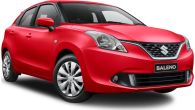It is about the time the exhaust kicks in that you suddenly realise this isn’t your average Hyundai.
It’s not so much the deep bass that accompanies every nudge of the accelerator (though that’s quite something, too), but the sharp cracks and bangs that erupt every time you back off the throttle, filling the cabin with these rapid-fire explosions so loud it’s like someone’s throwing cherry bombs into the backseat.
Of all the surprises on offer today, that exhaust is the one that really shocks. It’s all so aggressive. And so angry. And more than a little bit obnoxious. In short, it’s absolutely bloody fantastic.

It's the kind of sound that belongs on a snarling muscle car, or some tricked-up track weapon. But definitely not on Hyundai's top-selling small car, the i30 hatch - a car that could only be more safe and sensible if its voice command system was programmed to sound like your mum.
But then, this isn't just any i30. This is the brand’s first N-stamped performance model; the Korean’s turbocharged halo car that’s filled with genuine performance kit and designed to take the fight to hot-hatch heroes like the Golf GTI and Focus ST.
So has Hyundai at last arrived on the hot hatch scene? And is there more to the i30 N than an exhaust that could trigger earthquake warning systems?
Hyundai I30 2018: GO 1.6 Crdi
| Engine Type | Diesel Turbo 4, 1.6L |
|---|---|
| Fuel Type | Diesel |
| Fuel Efficiency | 4.5L/100km (combined) |
| Seating | 5 |
| Price From | $12,980 - $17,270 |
| Safety Rating |
|
Is there anything interesting about its design?
7 / 10
Think of it like a regular i30 that’s grown up on the wrong side of town (or maybe spent a brief stint inside). There are obvious similarities there, but it looks tougher, angrier and more aggressive.
The Euro-style makeover of the new i30, launched earlier this year, still looks good, only now the front-end is home to a new red-lipped kit that spills out of the '3D-effect' grille. Side on, the 18-inch (19-inch on the Performance Pack model) alloys are shielded by slightly bigger (but we’re not talking Mustang-level muscles here) wheel arches, while black side-skirting adds another hint of aggression. Step around to the back and you’ll find a black roof spoiler and a pair of exhaust tips that frame the rear diffuser.

Inside, only the N-stamped sport seats and wheel-mounted N buttons (that cycle through drive modes or leap directly to the most hardcore N settings) really differentiate it from the standard i30. Sadly, though, the cabin materials are lacking, with plenty of hard, cheap-feeling plastics astroturfing key touchpoints, and a sparse backseat devoid of vents, power outlets or much of anything really.
There’ll be six exterior colours on offer, including the baby blue (they call it 'Performance Blue') hero colour you see in these images.
How practical is the space inside?
7 / 10
The secret joy of any hot hatch is that, when you’re not pushing it along some twisting road, it’s every bit as practical as its not-hot siblings, and it’s as-per-program for the i30 N.
Up front, you’ll find ample cabin space, along with two cupholders, USB and power connections and room in each door for bottles. Climb into the back, and there’s another brace of cupholders hidden in the pulldown divider, along with single-bottle storage in each door. There are two ISOFIX attachment points, one in each window seat in the back.
.jpg)
Rear space is going to feel tight, especially if you try to squeeze three across the back (don’t), but adults can ride in comfort behind my 178cm driving position. The backseat is barren, though, with no vents, power or USB sources on offer.
Boot space is a listed 395 litres with the rear seats in place, swelling to 1301 litres with the 60/40 spit seats folded flat - though those numbers take the slightest battering should you opt to install the optional rear stiffness bar that is mounted at the base of the back seats.

Does it represent good value for the price? What features does it come with?
8 / 10
There’s nothing official yet, but Hyundai is promising each step of the N family will be priced below its most natural competitor (they're talking about the Golf GTI, we think). Or, in the words of one Hyundai executive; “We are not changing our position of value for money, we’re simply adding a new element: excitement”.
A new element is right. While Hyundai's have long been safe, practical and value-packed (and, in latter years, stylish to boot) the existing fleet is every bit as exciting as a bowl of wet kale.

So to change that, expect the i30 N to arrive in two variants - a standard car and a 'Performance Pack' model that ups the power, grip and sporty stuff - with each then available in two distinct trim levels. No matter which you pick, though, driving fun is the focus.
Pricing is still under wraps, but you can expect a starting point below $40k. That’s bang-on the money, too. The cheapest Golf GTI with a manual transmission, for example, will set you back $41,490, while the Ford Focus ST, again with a manual, starts at $38,990.
The same 8.0-inch floating screen that’s Apple CarPlay and Android Auto-equipped makes an appearance.
Full specification details are still being finalised ahead of the car’s Q1, 2018 local launch, but if you’re familiar with the regular i30 range, you’ll find plenty of similarities. The same 8.0-inch floating screen that’s Apple CarPlay and Android Auto-equipped makes an appearance, for example, but it gets a new driving data mode that includes g-force, power and torque readings, plus a lap timing function.
The standard N will ride on 18-inch alloys, while the Performance Pack car swaps them out for 19-inch rims fitted with Pirelli P Zero rubber (a custom compound for the car, no less). Every N car will also arrive with a launch control function, a rev-matching system for downshifting the manual 'box, adaptive suspension and adjustable drive modes that cycles through 'Eco', 'Normal', 'Sport' and the most hardcore 'N' setting.

Springing for the Performance Pack car ups the power, brakes, wheel size and adds some key go-fast kit like a limited-slip differential and that ferocious bi-modal exhaust (all things we couldn't live without, if we're honest).
What are the key stats for the engine and transmission?
8 / 10
It’s fabulous, this turbocharged 2.0-litre unit. It’s not a new engine, rather a repurposed product from the Hyundai stable, but the N engineers have gone to work on it, producing a thick and remarkably smooth flow of power from all over the rev range, with no noticeable lag.
In the standard car, that engine will produce 184kW at 6000rpm and 353Nm at a low 1450rpm, unlocking a 6.4 second 0-100km/h sprint time and a 250km/h top speed.

The Performance Pack car ups the oomph to 202kW at 6000rpm, while torque is an identical 353Nm. That’s enough of a boost to shave 0.3 seconds off the sprint to 100km/h. A limited overboost function can up the torque to 378Nm on both models.
Neither model offers real face-tearing acceleration, but we suspect that was never Hyundai's intention. And the flow of power feels perfectly suited to the product.
Both versions share the same six-speed manual gearbox (a dual-clutch automatic is en route, but is at least 12 months away) with one of the best rev-matching systems - automatically blipping the revs as you down-shift, eliminating the need to heel-and-toe - we’ve tested also fitted as standard.
How much fuel does it consume?
7 / 10
While official fuel use is pegged at a claimed 7.0L/100km for the combined cycle in the standard car (7.1 litres in the Performance Pack model), we rarely saw the number drop below 11.0L/100km on our (admittedly very vigorous) test.
That’s not a direct representation of the numbers you’ll see in everyday driving, of course, but you’re unlikely to be buying the N car to gently tootle around - there’s a whole fleet of regular i30s for that - so we don’t expect you’ll be seeing too many sevens in your fuelling future.
This is the first ever Hyundai to demand premium fuel of 95RON or higher, meaning it’ll cost more to fill the 50-litre tank.
Also worth noting is that this is the first ever Hyundai to demand premium fuel of 95RON or higher, meaning it’ll cost more to fill the 50-litre tank.
Emissions are a listed 159g/km of C02 in the standard 130N, and 163g/km in the Performance Pack car.
What's it like to drive?
9 / 10
Things like practicality, safety and value might be important factors in the new-car sales process, but they’re as skin-tinglingly exciting as watching astroturf grow.
Traditionally, of course, Hyundai’s cars have fallen squarely into the astroturf category - something its executives freely admit. But the i30 N doesn’t just shatter that trend, it leaves it deafened and quivering in its wake.

It's very, very easy to like the i30 N, no matter which specification you climb into. All the elements, from the suspension to the steering and engine, all feel so perfectly matched to each other that you can't help but smile as it goes about its perky, rorty business.
It's not the most hardcore thing in its segment, and if you're into shaving micro-seconds off lap times then there's undoubtedly more suitable options, but the N offers up something that no other Hyundai before it ever has, and that is great big bagfuls of fun.
Even in its standard and lower-powered mode, the turbocharged 2.0-litre engine is a gem, serving up a constant flow of lag-free power from just 1450rpm, and pulling cleanly in every gear. Torque steer can rear its head, most noticeably in the non-Performance Pack models, but it's easily managed and actually adds a little fanfare to hard acceleration.
You're always aware of grip levels, and when you're about to exceed them, allowing you to squeeze the most out of it on corner exits.
It’s not lightening-quick, but it feels so urgent and keen in every gear that it almost doesn't matter. The steering is great, too, direct and predictable, while the notchy, short-throw gearbox is a gem to work with.
Most impressive, though, is the easy predicability of it all. You're always aware of grip levels, and when you're about to exceed them, allowing you to squeeze the most out of it on corner exits. It's a little like the MX-5 in that sense, and every bit as fun. Again, it's not surgical (and it can be over-driven), but I suspect it's not meant to be. Fun is the aim of the game here, and it's plenty of that.
The Performance Pack car, of course, is a cut above. Strangely, it doesn’t actually feel much faster, but the upgraded components (the better rubber, limited-slip differential and that cracking, crackling exhaust) make for a sharper package. If you nurse dreams of heading to a track, this is the version for you.

Downsides? Well, even in its softest settings, broken roads are going to be an issue, sending sharp bumps into the cabin. It's predictably worse in its most hardcore N set-up - a setting you'll be using sparingly unless you live on roads smoother than your average frozen lake.
The exhaust too, so loud and exciting in the Performance Pack car, does drone on like parliamentary question time on the freeway, though it can be switched off. And finally, the turning circle is almost comically bad, turning even easy U-turns into Austin Powers-style manoeuvres.
Warranty & Safety Rating
What safety equipment is fitted? What safety rating?
7 / 10
So far in Australia, manual-equipped i30s have missed out on some advanced safety stuff because those systems are yet to be configured for a self-shifting set-up, but our international test cars were fitted with AEB, lane keep assist and road-sign recognition technology. It remains to be seen if that stuff will appear as standard in Australia, and if so, on what trim levels.
Either way, expect an i30 SR-matching seven airbags, along with blind-spot monitoring, reversing camera with rear cross-traffic alert and rear parking sensors.
What does it cost to own? What warranty is offered?
8 / 10
The i30 N will be offered with a five-year, unlimited-kilometre warranty, and should demand a trip to the service centre every 12 months or 15,000kms - though that will be confirmed closer to launch.
The i30 N will also fall under Hyundai's very good capped-price-servicing program, though specific costs are yet to be confirmed.
Verdict
It’s a first attempt at a performance car that feels like it has been built by old hands. It’s not the most hardcore offering in the segment, or the most premium-feeling inside, but it serves up plenty of fun behind the wheel in a really engaging, exciting way that feels a million lightyears away from all the things Hyundai has become so well known for.
Do you think the Hyundai i30 N shapes up as a serious hot hatch contender? Tell us what you think in the comments below.
Pricing Guides

Range and Specs
| Vehicle | Specs | Price* |
|---|---|---|
| Active | 1.6L, Diesel, 6 SPEED MANUAL | $13,750 - $18,040 |
| Active 1.6 Crdi | 1.6L, Diesel, 6 SPEED MANUAL | $13,750 - $18,150 |
| GO 1.6 Crdi | 1.6L, Diesel, 6 SPEED MANUAL | $12,980 - $17,270 |


.jpg)





































.jpg)





